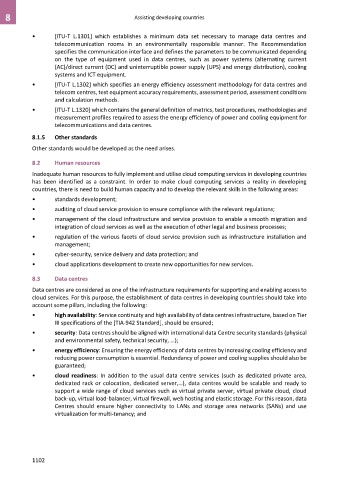Page 1110 - Cloud computing: From paradigm to operation
P. 1110
8 Assisting developing countries
• [ITU-T L.1301] which establishes a minimum data set necessary to manage data centres and
telecommunication rooms in an environmentally responsible manner. The Recommendation
specifies the communication interface and defines the parameters to be communicated depending
on the type of equipment used in data centres, such as power systems (alternating current
(AC)/direct current (DC) and uninterruptible power supply (UPS) and energy distribution), cooling
systems and ICT equipment.
• [ITU-T L.1302] which specifies an energy efficiency assessment methodology for data centres and
telecom centres, test equipment accuracy requirements, assessment period, assessment conditions
and calculation methods.
• [ITU-T L.1320] which contains the general definition of metrics, test procedures, methodologies and
measurement profiles required to assess the energy efficiency of power and cooling equipment for
telecommunications and data centres.
8.1.5 Other standards
Other standards would be developed as the need arises.
8.2 Human resources
Inadequate human resources to fully implement and utilise cloud computing services in developing countries
has been identified as a constraint. In order to make cloud computing services a reality in developing
countries, there is need to build human capacity and to develop the relevant skills in the following areas:
• standards development;
• auditing of cloud service provision to ensure compliance with the relevant regulations;
• management of the cloud infrastructure and service provision to enable a smooth migration and
integration of cloud services as well as the execution of other legal and business processes;
• regulation of the various facets of cloud service provision such as infrastructure installation and
management;
• cyber-security, service delivery and data protection; and
• cloud applications development to create new opportunities for new services.
8.3 Data centres
Data centres are considered as one of the infrastructure requirements for supporting and enabling access to
cloud services. For this purpose, the establishment of data centres in developing countries should take into
account some pillars, including the following:
• high availability: Service continuity and high availability of data centres infrastructure, based on Tier
III specifications of the [TIA-942 Standard], should be ensured;
• security: Data centres should be aligned with international data Centre security standards (physical
and environmental safety, technical security, …);
• energy efficiency: Ensuring the energy efficiency of data centres by increasing cooling efficiency and
reducing power consumption is essential. Redundancy of power and cooling supplies should also be
guaranteed;
• cloud readiness: In addition to the usual data centre services (such as dedicated private area,
dedicated rack or colocation, dedicated server,…), data centres would be scalable and ready to
support a wide range of cloud services such as virtual private server, virtual private cloud, cloud
back-up, virtual load-balancer, virtual firewall, web hosting and elastic storage. For this reason, data
Centres should ensure higher connectivity to LANs and storage area networks (SANs) and use
virtualization for multi-tenancy; and
1102

